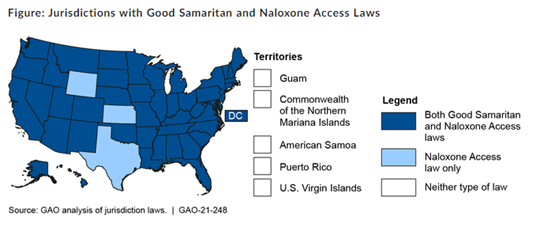In 2022 alone there were 79,770 opioid overdoses that resulted in death across the United States. According to the CDC, this accounted for over 75% of all drug overdose related deaths in 2021. With the continued rise in opioid-related overdoses, more people are likely to encounter situations where they potentially may have to assist someone who is experiencing an overdose.
The life-threatening realities surrounding the opioid epidemic raises many concerns, including how to handle an overdose in the workplace. Of course, an incident at the workplace is more relevant for the sectors that treat, house, counsel and otherwise care for people who struggle with addiction. But the prevalence of opioid abuse will undoubtedly spread into other industries, including construction and manufacturing.
Prepare now for potential overdoses
Fortunately, there is a treatment that can be administered easily and safely as a nasal spray by almost anyone and can work to undo the effects of an opioid overdose. Naloxone (more commonly known as Narcan) is a life-saving medication that can reverse an overdose from opioids, including heroin, fentanyl and prescription opioid medications, when given within a certain time frame.
National Institutes of Health report a 75-100% success rate when Naloxone is given correctly. As Naloxone becomes more widely available to the public, many businesses are, or maybe considering, keeping doses on-hand in the workplace. Despite the ease of use and impressive results, some businesses may still be concerned about the liability involved with administering Naloxone.
Coverage of Good Samaritan laws
Naloxone generally has minimal side effects. Even if it is used on someone who is not experiencing an overdose, it should not cause any harm. When administered in good faith and under reasonable circumstances, those who use the nasal spray on a person they believe is experiencing an overdose should be protected by Good Samaritan laws.
As shown above, every state has either a Good Samaritan Law and/or Naloxone Access Laws in place. Access Laws govern how Naloxone can be obtained. For example, in Missouri, there is a statewide standing order from the State Health Officer that allows pharmacists to dispense Naloxone to anyone at risk or in a position to help someone at risk without a prescription.
Good Samaritan laws are in place to insulate individuals when providing aid to someone in distress. Other than administering a dose of Naloxone to a potential overdosing victim, examples of providing CPR or the use of an AED machine are also covered by Good Samaritan laws. In each circumstance liability is not fully absolved if the actions of the Samaritan are reckless to the point that they make the victim’s situation worse or injures the person further.
However, if the emergency actions taken are done so in good faith and are reasonable under the circumstances, a person should be protected under the Good Samaritan Law. Additionally, it is important to make sure emergency medical professionals are notified when Naloxone is administered as the individual may need additional care.
Continued protections
In his blog, Naloxone (Narcan): The Fight Against the Opioid Epidemic, The Miller Group’s Director of Safety Aaron Paris discussed the warning signs of an opioid overdose and the most common way to respond by using Naloxone. In the workplace, it is recommended that prior to having Naloxone as an option, employees are trained and policies are put in place. The Alliance for Naloxone Safety in the Workplace has developed one such policy template. Additionally, it is recommended that an attorney assist with identifying all liability risks prior to activating such a policy.
The opioid epidemic presents an ongoing and formidable challenge, affecting not only those directly involved in addiction services but also others in various capacities. By ensuring that you and your employees are equipped with the necessary knowledge of Naloxone, including its administration via nasal spray and understanding the legal protections in place for those who provide assistance, you can actively contribute to addressing the crisis.
For more information about the opioid epidemic and what steps are being taken to combat overdoses, please visit your state’s health and safety website. There you can find laws and other imperative information specific to your state and region.
*This blog is not intended to serve as legal advice for individual fact-specific legal cases or as a legal basis for your employment practices.
Webinar recap:
Learn how naloxone can become a life-saving resource at your organization. Our panel discussed costs, training and the right policies to put into place in our webinar recap over Addressing The Opioid Crisis.


